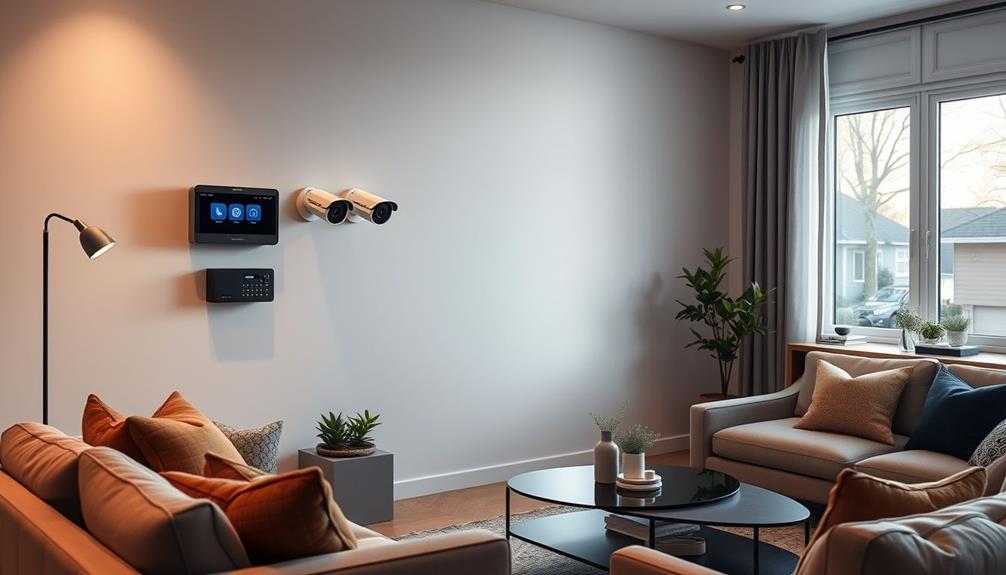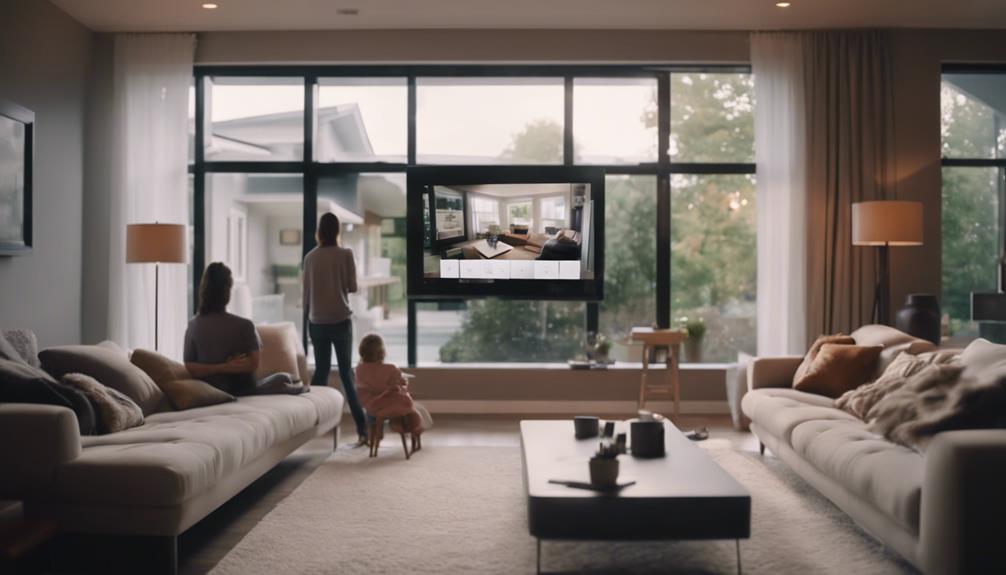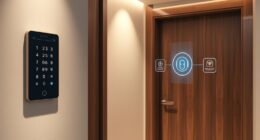To stop your home security system, first inform your alarm company to avoid false alarms. Then, turn off the alarm using the control panel or mobile app and check for any backup batteries. Shut off the power by flipping the correct circuit breaker, then disconnect the backup battery safely. Take out the control panel and untangle any extra components—remember to cap any exposed wires. Lastly, obey local rules for disposing of old equipment correctly. For more details on each step and ensuring a seamless disconnection, there is plenty of helpful information coming up.
Key Takeaways
- Notify your alarm company about your disconnection plans to avoid false alarms and clarify monitoring service impacts.
- Disable the alarm system using the disarm code and set the control panel to maintenance mode before disconnecting power.
- Disconnect the main power supply by turning off the circuit breaker and removing the backup battery safely.
- Carefully remove wiring connections, capping exposed wires with wire nuts or electrical tape to prevent accidental contact.
Assessing Alarm Components
Before you disconnect your home security system, take a close look at all the components, like the control panel, sensors, cameras, and sirens, to figure out what you can keep or remove.
Start by evaluating the functionality of each component. Determine which parts are outdated or no longer meet your needs. For instance, if you've upgraded your technology, some sensors may not be necessary anymore. Additionally, it's wise to research the best cleaning products for maintaining your home's cleanliness during this change, as a tidy environment can make the process easier.
Next, examine the wiring within your system. Often, only damaged or unnecessary wiring needs to be removed during the upgrade or disconnection process. If the wiring looks unsightly or interferes with the installation of a new security system, make a note to address it.
Make a list of the components you can keep, as well as those that should be removed. This will streamline the disconnection process and improve your home's aesthetics.
If you're unsure about any wiring or how to safely disconnect power from outdated components, consulting a licensed electrician is a smart move. They can guide you on what to keep or remove while ensuring safety throughout the process.
Notifying Your Alarm Company

Before you disconnect your home security system, it's essential to notify your alarm company.
This step helps prevent any false alarms and guarantees they can confirm the system's status.
Additionally, it's wise to take into account safety features in the home to maintain security during the disconnection process.
Plus, getting specific instructions from them will make the disconnection process smoother.
Informing the Provider
Inform your alarm company about your plans to disconnect the system to prevent false alarms and guarantee a smooth swap. It's vital to notify the provider before making any disconnection changes. This way, they can prepare for the scheduled disconnection and avoid unnecessary emergency responses, which could lead to fines for false alarms.
Additionally, if you're considering upgrading your home entertainment setup, make sure to assess your audio connection options, such as optical audio cables, which can enhance your overall experience.
When you inform the alarm company, make sure to communicate that you're either removing or upgrading your security system. They may have specific procedures you need to follow. If your system is tied to a monitoring service, discuss how disconnection will impact your home security coverage and response protocols.
Document all communication with the alarm company, as this provides a reference for future needs and confirms any agreed-upon actions. By keeping them in the loop, you make certain that your changeover is as seamless as possible.
Whether you're changing your system or simply taking a break from monitoring, clear communication with your alarm company is essential for maintaining security and preventing any hiccups during the process.
Preventing False Alarms
In order to prevent false alarms during the disconnection of your home security system, it's crucial to notify your alarm company about your plans. This proactive communication helps avoid unnecessary fines and emergency responses triggered by monitoring services detecting power loss or tampered wires.
Additionally, ensuring your home is properly insulated can help maintain a stable environment while you're without security, which is something to reflect on when evaluating your overall home systems, including energy-efficient alternatives like heat pumps that can provide both heating and cooling functions energy-efficient alternatives.
Here are some key steps to follow:
- Contact Your Alarm Company: Inform them of your intention to disconnect the system, ensuring they understand your plans.
- Document Communication: Keep a record of your discussions with the alarm company, including any specific instructions or guidelines they provide.
- Follow Their Guidelines: Some companies offer detailed instructions for safely disconnecting the wires to minimize the risk of false alarms.
- Schedule Disconnection: If possible, arrange the disconnection for a time when monitoring services are less active, reducing the chance of alarm triggers.
Confirming System Status
Contacting your alarm company is essential for confirming the status of your security system before you proceed with disconnection. Notifying your provider about your plans can help prevent false alarms that could lead to unnecessary emergency responses and fines. Document any communication regarding disconnection to keep a record of your request.
Your alarm company may provide specific instructions for safely disconnecting your system without triggering alerts. Failing to notify them can lead to police dispatch if they detect a power loss or tampering, which can be costly and disruptive. Here's a quick reference table to guide you:
| Action | Importance |
|---|---|
| Contact your alarm company | Prevents false alarms and fines |
| Notify them of disconnection | Guarantees safety and monitoring status |
| Follow provided instructions | Guarantees proper disconnection |
Disabling the Alarm

Disabling your alarm system is simple; just enter the disarm code on the control panel or use the mobile app for quick access.
If your system's beeping due to a low or dead backup battery, replace or disconnect the battery to stop the sound.
Before you proceed with any disconnection or removal, make certain that the control panel is set to maintenance mode or completely powered down.
It's important to create a calming atmosphere during this process, perhaps by diffusing essential oils known for relaxation, such as lavender and chamomile.
Here's a quick checklist to help you disable your alarm effectively:
- Enter the disarm code on the control panel or mobile app.
- Check the user manual if you can't access the disarm code and contact the alarm company for assistance.
- If your system is linked to monitoring services, notify the alarm company to prevent false alarms.
- Once you've disarmed the system, consider placing the control panel in maintenance mode before disconnecting any components.
Disconnecting Power Sources

After verifying your alarm system is disarmed, you can safely disconnect the power sources to complete the process. First, locate the main control panel of your security system to access the power supply. Identify the circuit breaker connected to it and flip the breaker switch to disconnect power from the system. This step prevents any potential electrical shocks while you work. It's also wise to take into account safety precautions similar to those used in essential kitchen gadgets, as handling electrical components requires careful attention.
Next, you'll need to remove the backup batteries. Carefully disconnect the black and red wires to eliminate any remaining power supply. To keep yourself safe, make sure to wear insulated gloves while handling the wires. This precaution helps prevent accidental contact with live circuits during the disconnection process.
Once you've disconnected everything, it's vital to cap the wires using wire nuts or electrical tape. This prevents future accidental contact and guarantees your safety. Remember, if your old security system provider had specific instructions, you might want to refer to their guidelines as well.
When the power sources are properly disconnected, your system loses its functionality, allowing you to proceed with the next steps in deactivating your home security system.
Removing the Control Panel

Before you start removing the control panel, make certain to prioritize safety by turning off the power supply. This precaution is essential to guarantee that you prevent any accidental shocks, similar to how effective communication skills facilitate collaboration in software quality assurance.
Once you've confirmed it's powered down, you can carefully unscrew the panel from the wall and prepare to handle the wiring connections. This step is important to prevent any accidental shocks or damage during the removal process.
Safety Precautions First
It's vital to power down the system completely before you start removing the control panel to avoid any accidents. This step guarantees your safety while handling electrical components and prevents any accidental alarms from triggering.
Here are some safety precautions to follow:
- Disconnect the main power supply: Turn off the circuit breaker to guarantee there's no electricity flowing to the system.
- Remove the backup battery: Detach the backup battery to eliminate any residual power that could pose a risk.
- Use a voltage tester or multimeter: Always check for any remaining voltage before touching any wires. This confirms that the system is completely powered down.
- Wear rubber-insulated work gloves: Protect yourself from electrical shocks while working with wiring connections.
Once you've removed the control panel, be sure to cap off any exposed wires with wire caps. This step is imperative for preventing accidental contact, safeguarding safety for anyone who might enter the area in the future.
Taking these precautions will help you safely disconnect your home security system without incident.
Disconnecting Power Supply
With the safety precautions in place, you can now focus on disconnecting the power supply by removing the control panel from your home security system.
Start by locating the main control panel and turning off the breaker that supplies power to the system. This guarantees safety during removal.
Once the power is off, disconnect the backup battery by removing both the black and red wires to eliminate any remaining power source.
Next, use a voltage tester to confirm that no electricity is present before you proceed with detaching any components from the control panel.
Carefully unscrew and detach the control panel from its mounting, being mindful of the bundle of wires that may be present.
After removal, you'll likely encounter some exposed wires. To prevent accidental contact with live circuits, cap off any exposed wires using wire caps or wrap them securely with electrical tape.
Removing Wiring Connections
To safely remove the control panel, you'll need to disconnect the wiring connections carefully to avoid any damage or hazards. Start by ensuring your system is powered down. Here's a step-by-step guide to help you:
- Disconnect the Power Supply: Flip the circuit breaker associated with the alarm system to cut off all power.
- Check for Residual Power: Use a voltage tester to confirm there's no remaining power before you proceed.
- Remove the Control Panel: Unscrew the panel from the wall, ensuring you support it while detaching any connected wiring to avoid damage.
- Disconnect the Backup Battery: If your control panel has a backup battery, disconnect the black and red wires from it first for safety.
After removing the control panel, cap off any exposed wires with wire nuts or electrical tape. This step is essential to prevent accidental contact with live circuits.
Detaching Additional Components

Before you start detaching additional components like motion sensors and cameras, make sure the power to the entire security system is turned off to avoid electrical hazards. This is essential for your safety.
Depending on your system, some components may be secured with screws or adhesive. Use the right tools to remove them carefully without damaging the surrounding surfaces.
As you remove each component, keep track of how they're connected in case you need to reconnect them later. If the components are connected with wires, gently disconnect them, making sure to cap off any exposed wires to prevent accidental contact with live circuits.
Document this process and note the types of components you've removed; it'll be helpful if you decide to install a new system later.
After removing any adhesive, clean the surface with rubbing alcohol and a cotton swab to maintain a neat appearance on your walls.
Once everything is safely disconnected and cleaned, you'll have successfully detached additional components from your wireless security system, paving the way for future plans.
Responsible Disposal of Equipment

After detaching your security system's components, it's crucial to contemplate how to responsibly dispose of the equipment. Improper disposal can lead to hazardous electronic waste, so it's vital to follow best practices. Here are some steps to make sure you handle it properly:
- Check Local Regulations: Research your municipality's guidelines on electronic waste to guarantee compliance with responsible disposal methods.
- Utilize Recycling Programs: Many areas have designated e-waste recycling programs or drop-off locations specifically for items like alarm systems and cameras.
- Remove Batteries: Always take out batteries from devices before disposal since they can be hazardous. Recycle them separately at designated battery recycling facilities.
- Donate Functional Equipment: If any components are still working, consider donating them to community organizations or local charities that may benefit from security equipment.
Before you dispose of any device, make sure to securely erase any personal data or settings stored on it. This protects your privacy and prevents unauthorized access. By following these steps, you contribute to sustainable practices while promoting responsible disposal of your equipment.
Frequently Asked Questions
Can I Just Unplug My Security System?
You can't just unplug your security system, as it may still trigger alarms due to backup batteries. It's best to notify your alarm company and follow their specific disconnection instructions to avoid issues.
How Do I Deactivate a House Alarm?
When the alarm's siren wails like a banshee, you'll want to restore peace. To deactivate it, simply enter your disarm code on the control panel or use your mobile app for instant tranquility.
Can I Cancel My Home Security System?
Yes, you can cancel your home security system. Just contact your alarm company, review your contract for cancellation terms, and follow their specific procedures to avoid extra charges. Don't forget to confirm everything in writing.
Can an Electrician Disconnect a House Alarm?
Absolutely, an electrician can disconnect your house alarm safely. They'll handle everything, ensuring no sparks fly while capping wires. Trust their expertise; it's like having a safety net when maneuvering through the complexities of electrical systems.
Is it Safe to Disconnect My Home Security System on My Own?
Attempting to handle disconnecting home security system on your own could leave your home vulnerable to threats. It’s best to seek professional assistance to ensure it’s done safely and effectively. Cutting corners with your home’s security could have detrimental consequences.
Conclusion
Now that you've carefully disconnected your home security system, take a moment to reflect.
Did you remember to notify the alarm company? What if they call, expecting a response?
As the last wires come loose, a sense of unease may creep in.
You've dismantled your shield—are you truly ready for what comes next?
The silence is palpable, and the world outside seems a little more intimidating.
Trust your instincts, and be prepared; you never know what awaits.









